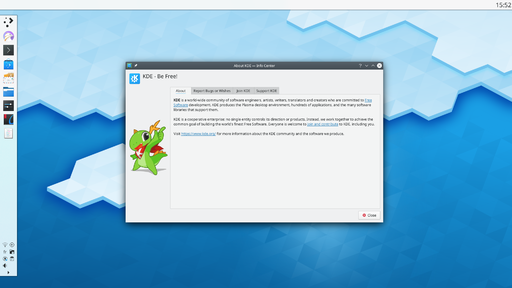Plasma/Panels/uk: Difference between revisions
Created page with "Впорядкувати віджети на панелі можна перетягуванням цих віджетів у режимі налаштування. Віджети..." |
Created page with "=== Інструмент керування панеллю ===" |
||
| Line 15: | Line 15: | ||
Впорядкувати віджети на панелі можна перетягуванням цих віджетів у режимі налаштування. Віджети вирівнюються ліворуч на горизонтальній та праворуч на вертикальній панелі. | Впорядкувати віджети на панелі можна перетягуванням цих віджетів у режимі налаштування. Віджети вирівнюються ліворуч на горизонтальній та праворуч на вертикальній панелі. | ||
=== | === Інструмент керування панеллю === | ||
*<menuchoice>Screen Edge</menuchoice>: Allows you to drag the panel to any of the four edges of the screen. | *<menuchoice>Screen Edge</menuchoice>: Allows you to drag the panel to any of the four edges of the screen. | ||
Revision as of 09:01, 30 June 2011
Панелі стільниці Плазми

A Panel is a widget container which can be located on any side of the desktop. There can be multiple panels on the same side. The default layout is one panel that stretches across the entire bottom of the desktop with the following widgets: application menu, desktop pager, task manager (list of open windows), system tray, device notifier and clock. If you are using a laptop, netbook or other computer that uses a battery there will also be a power management widget on the panel. At the end of the panel is a toolbox button which can be activated to access configuration options.
Налаштування
The panel can then be configured by clicking on the toolbox located on the right for horizontal or bottom for vertical panel. At that point, the panel will be in configuration mode. Panel configuration may also be accessed via the context (right click) menu in the panel.

Впорядкувати віджети на панелі можна перетягуванням цих віджетів у режимі налаштування. Віджети вирівнюються ліворуч на горизонтальній та праворуч на вертикальній панелі.
Інструмент керування панеллю
- : Allows you to drag the panel to any of the four edges of the screen.
- (for horizontal panel): Allows the panel height to be adjusted.
- (for vertical panel): Allows the panel width to be adjusted.
- : Allows widgets to be added to the panel.
- : Allows you to add a spacer into the panel giving space between the items in it.
- The standard behavior of a spacer is that it uses as much space as possible (flexible size), but you can also set it to a . Enter the context (right click) menu and deactivate .
- : Locks the panel and widgets in position. Also hides the toolbox.
The "More Settings" Menu
- : Allows the alignment of the panel to be set in three pre-set positions.
-
- : Keeps the panel visible at all times, even when windows are maximised.
- : Hides the panel off screen until the mouse is placed near the screen edge.
- : This allows windows to cover the panel and if maximised, will cover the panel.
- : This allows windows to go below the panel, even when maximised.
- : Makes the panel fit to the screen edges, if it has been resized.
- : Removes the current panel and all widgets in it.
Multiple Panels
It is also possible to have more than one panel on your desktop. This proves useful if you want to have a more flexible layout:

Adding a Panel
To add a new panel either click on the desktop toolbox button and select or open the context (right click) menu on the desktop and select from the menu.
If more than one kind of Panel is installed, you will be able to select between them to choose what sort of Panel you would prefer. By default, two Panel types are available: , which creates a Panel containing all of the default widgets (launcher, pager, tasks, system tray, clock, etc.), and , which adds an empty Panel without any pre-configured widgets in it.
Locking
The panels and desktop may be locked to prevent changes being made to them. When locked, the toolbox buttons will not be shown on either the desktop or on the panels. To configure a panel, it must be unlocked, otherwise the toolbox and context menu entries to configure or add widgets are unavailable.
Locking can be done by either selecting the entry in the Panel toolbox's menu or in the Panel context (right click) menu. Once locked, the Panels can be unlocked again by right clicking on either a panel or desktop and selecting from the menu that is displayed.
